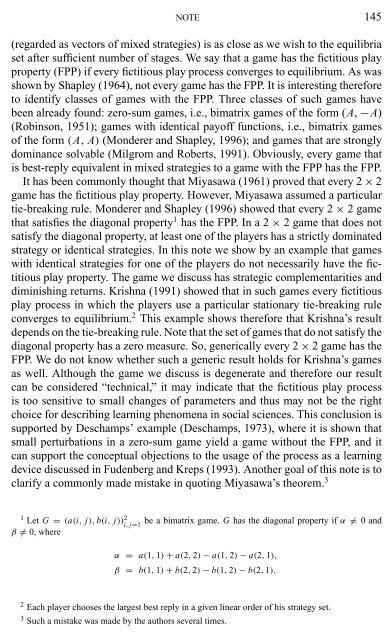A 2 x 2 Game without the Fictitious Play Property - David Levine's ...
A 2 x 2 Game without the Fictitious Play Property - David Levine's ...
A 2 x 2 Game without the Fictitious Play Property - David Levine's ...
Create successful ePaper yourself
Turn your PDF publications into a flip-book with our unique Google optimized e-Paper software.
NOTE 145<br />
(regarded as vectors of mixed strategies) is as close as we wish to <strong>the</strong> equilibria<br />
set after sufficient number of stages. We say that a game has <strong>the</strong> fictitious play<br />
property (FPP) if every fictitious play process converges to equilibrium. As was<br />
shown by Shapley (1964), not every game has <strong>the</strong> FPP. It is interesting <strong>the</strong>refore<br />
to identify classes of games with <strong>the</strong> FPP. Three classes of such games have<br />
been already found: zero-sum games, i.e., bimatrix games of <strong>the</strong> form (A, −A)<br />
(Robinson, 1951); games with identical payoff functions, i.e., bimatrix games<br />
of <strong>the</strong> form (A, A) (Monderer and Shapley, 1996); and games that are strongly<br />
dominance solvable (Milgrom and Roberts, 1991). Obviously, every game that<br />
is best-reply equivalent in mixed strategies to a game with <strong>the</strong> FPP has <strong>the</strong> FPP.<br />
It has been commonly thought that Miyasawa (1961) proved that every 2 × 2<br />
game has <strong>the</strong> fictitious play property. However, Miyasawa assumed a particular<br />
tie-breaking rule. Monderer and Shapley (1996) showed that every 2 × 2 game<br />
that satisfies <strong>the</strong> diagonal property 1 has <strong>the</strong> FPP. In a 2 × 2 game that does not<br />
satisfy <strong>the</strong> diagonal property, at least one of <strong>the</strong> players has a strictly dominated<br />
strategy or identical strategies. In this note we show by an example that games<br />
with identical strategies for one of <strong>the</strong> players do not necessarily have <strong>the</strong> fictitious<br />
play property. The game we discuss has strategic complementarities and<br />
diminishing returns. Krishna (1991) showed that in such games every fictitious<br />
play process in which <strong>the</strong> players use a particular stationary tie-breaking rule<br />
converges to equilibrium. 2 This example shows <strong>the</strong>refore that Krishna’s result<br />
depends on <strong>the</strong> tie-breaking rule. Note that <strong>the</strong> set of games that do not satisfy <strong>the</strong><br />
diagonal property has a zero measure. So, generically every 2 × 2 game has <strong>the</strong><br />
FPP. We do not know whe<strong>the</strong>r such a generic result holds for Krishna’s games<br />
as well. Although <strong>the</strong> game we discuss is degenerate and <strong>the</strong>refore our result<br />
can be considered “technical,” it may indicate that <strong>the</strong> fictitious play process<br />
is too sensitive to small changes of parameters and thus may not be <strong>the</strong> right<br />
choice for describing learning phenomena in social sciences. This conclusion is<br />
supported by Deschamps’ example (Deschamps, 1973), where it is shown that<br />
small perturbations in a zero-sum game yield a game <strong>without</strong> <strong>the</strong> FPP, and it<br />
can support <strong>the</strong> conceptual objections to <strong>the</strong> usage of <strong>the</strong> process as a learning<br />
device discussed in Fudenberg and Kreps (1993). Ano<strong>the</strong>r goal of this note is to<br />
clarify a commonly made mistake in quoting Miyasawa’s <strong>the</strong>orem. 3<br />
1 Let G = (a(i, j), b(i, j)) 2<br />
i, j=1 be a bimatrix game. G has <strong>the</strong> diagonal property if α = 0 and<br />
β = 0, where<br />
α = a(1, 1) + a(2, 2) − a(1, 2) − a(2, 1),<br />
β = b(1, 1) + b(2, 2) − b(1, 2) − b(2, 1).<br />
2 Each player chooses <strong>the</strong> largest best reply in a given linear order of his strategy set.<br />
3 Such a mistake was made by <strong>the</strong> authors several times.
















